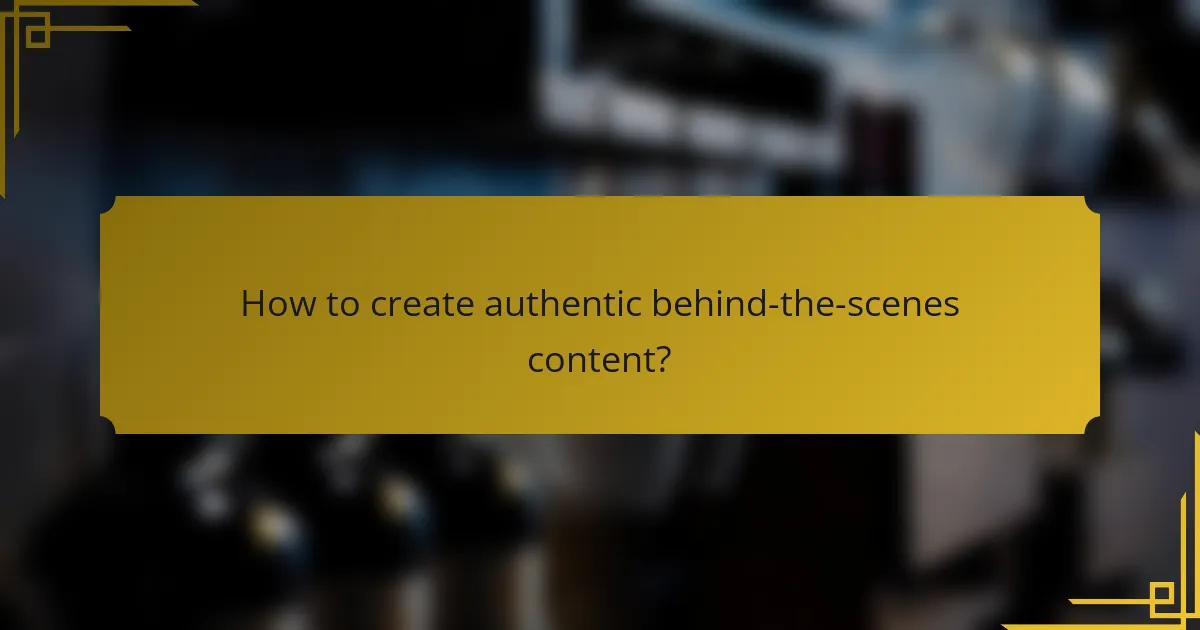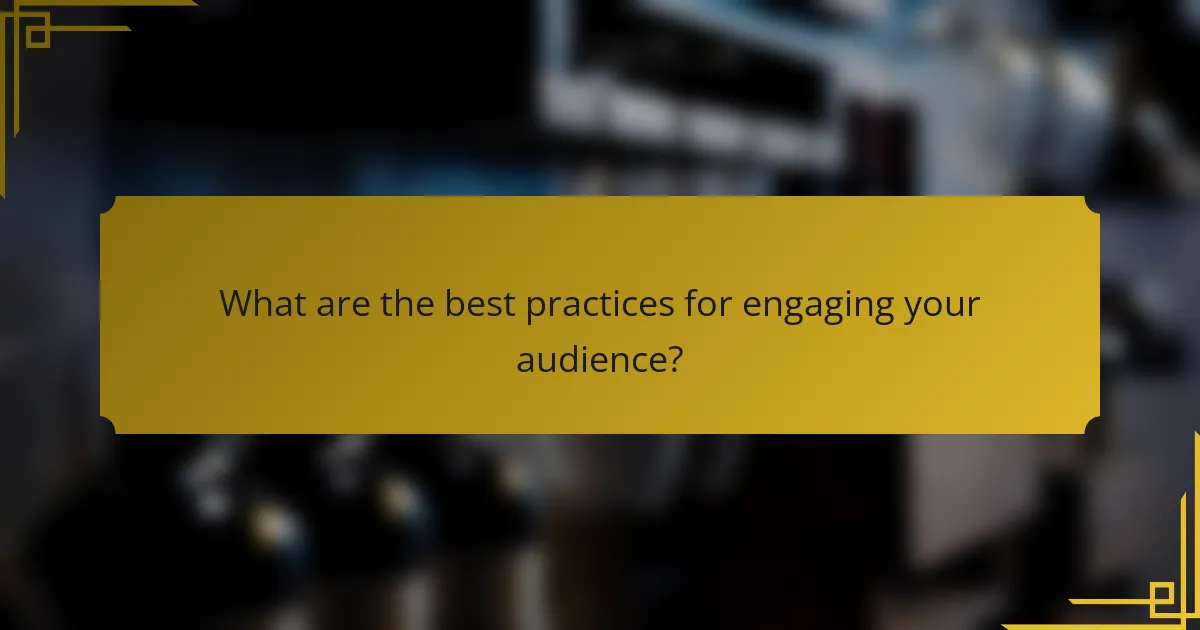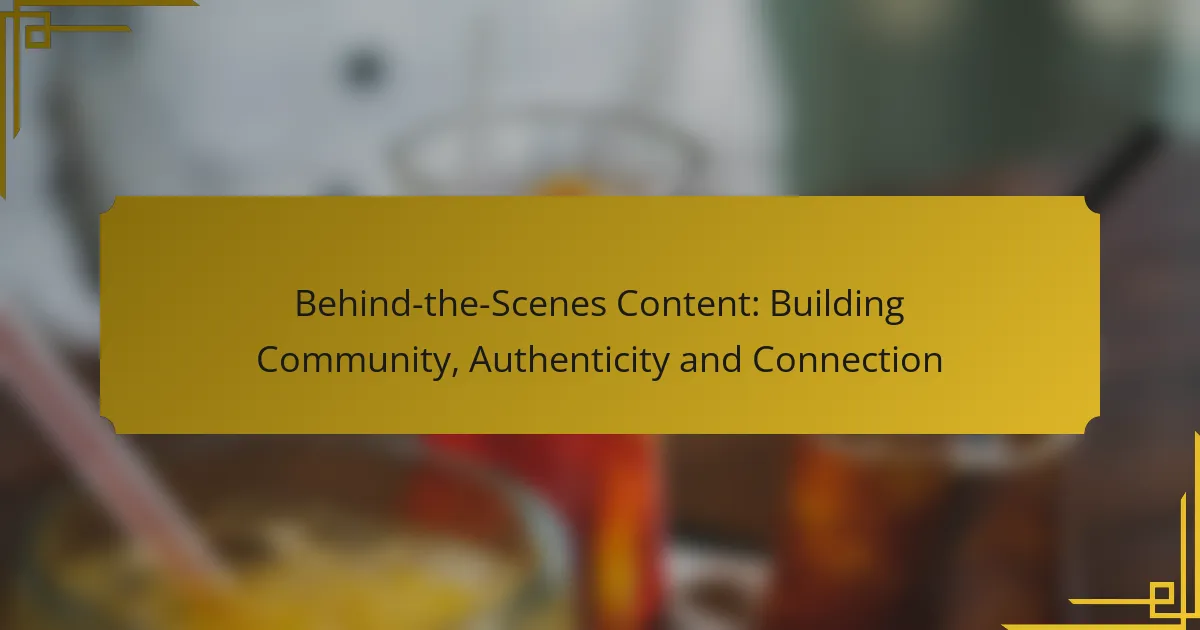Behind-the-scenes content plays a crucial role in building community by fostering a sense of belonging and connection among followers. By showcasing the human side of a brand, it encourages genuine interactions and engagement, ultimately leading to increased trust and loyalty. Sharing authentic insights and experiences allows brands to create relatable narratives that resonate deeply with their audience.

How can behind-the-scenes content build community?
Behind-the-scenes content fosters community by creating a sense of belonging and connection among followers. It allows audiences to see the human side of a brand, encouraging interaction and engagement.
Fosters engagement through transparency
Transparency in behind-the-scenes content invites audiences to witness the processes and decisions that shape a brand. This openness can lead to increased trust, as followers feel more informed and involved in the brand’s journey.
For example, sharing the making of a product or the day-to-day operations can spark conversations and questions, enhancing engagement. Brands can use live streams or social media stories to showcase real-time activities, making the audience feel like part of the experience.
Encourages user-generated content
Behind-the-scenes content can inspire followers to create their own content related to the brand. When audiences see the effort and creativity behind a product, they may be motivated to share their experiences or interpretations.
Brands can encourage this by hosting contests or challenges that invite users to share their own behind-the-scenes moments. This not only enriches the community but also provides valuable content that can be shared across platforms.
Strengthens brand loyalty
When brands share behind-the-scenes content, they cultivate a deeper emotional connection with their audience, which can enhance loyalty. Followers who feel connected to the brand’s story are more likely to become repeat customers.
To leverage this, brands should consistently share authentic and relatable content that reflects their values. Highlighting team members, showcasing community involvement, or sharing challenges faced can resonate with audiences and reinforce their commitment to the brand.

What are the benefits of authenticity in content?
Authenticity in content fosters genuine connections with the audience, leading to numerous benefits such as increased trust, customer loyalty, and brand visibility. By presenting real stories and experiences, brands can create a more relatable and engaging narrative that resonates with their audience.
Enhances trust with the audience
Authentic content builds trust by showing transparency and honesty. When brands share real experiences, challenges, and successes, they demonstrate vulnerability, which can resonate deeply with consumers. This trust often translates into stronger relationships and a loyal customer base.
To enhance trust, brands should avoid overly polished or scripted content. Instead, sharing behind-the-scenes insights, customer testimonials, or user-generated content can create a more relatable image. For instance, a clothing brand might showcase real customers wearing their products in everyday settings rather than using only professional models.
Improves customer retention
Authenticity contributes to higher customer retention rates by fostering emotional connections. When customers feel a brand is genuine, they are more likely to return for future purchases. This loyalty can be cultivated through consistent, authentic messaging across various platforms.
Brands can improve retention by regularly engaging with their audience through authentic content, such as newsletters featuring personal stories or social media posts that invite feedback. Offering exclusive content or rewards for loyal customers can also reinforce their connection with the brand.
Increases brand visibility
Authentic content can significantly boost brand visibility by encouraging sharing and engagement. When audiences connect with genuine stories, they are more likely to share that content with their networks, expanding the brand’s reach organically.
To maximize visibility, brands should create shareable content that resonates with their audience’s values and interests. This could include relatable blog posts, engaging videos, or interactive social media campaigns that invite participation. Utilizing relevant hashtags and collaborating with influencers can further enhance visibility in targeted communities.

How to create authentic behind-the-scenes content?
Creating authentic behind-the-scenes content involves sharing genuine insights and experiences that resonate with your audience. This type of content fosters connection and builds community by showcasing the real people and processes behind your brand.
Utilize storytelling techniques
Storytelling is a powerful way to engage your audience and convey your brand’s message. By framing your behind-the-scenes content as a narrative, you can highlight challenges, successes, and the journey of your team. Consider using a beginning, middle, and end structure to create a compelling story.
Incorporate elements such as conflict, resolution, and character development to make your content relatable. For example, share a specific project that faced obstacles and how the team overcame them, emphasizing teamwork and creativity.
Showcase real team members
Featuring actual team members in your behind-the-scenes content humanizes your brand and fosters authenticity. Highlight their roles, skills, and personal stories to create a connection with your audience. This can include short interviews, day-in-the-life segments, or candid photos of team activities.
Encourage team members to share their perspectives and experiences, which can add depth to your content. For instance, a video where employees discuss their favorite projects can illustrate the passion and dedication behind your brand.
Share unfiltered experiences
Unfiltered experiences provide a raw and honest look at your brand, which can resonate deeply with your audience. Share both successes and failures to create a balanced view of your operations. This transparency can build trust and loyalty among your followers.
Consider documenting a project from start to finish, including setbacks and lessons learned. Use social media stories or blog posts to share real-time updates, allowing your audience to witness the process as it unfolds. This approach not only engages viewers but also invites them to be part of your journey.

What tools can help in content creation?
Several tools can significantly enhance content creation by streamlining processes and improving quality. These tools cater to various aspects of content, including visual design, video editing, and social media management.
Canva for visual content
Canva is a user-friendly graphic design tool that allows creators to produce visually appealing content without needing extensive design skills. It offers a wide range of templates for social media posts, presentations, and marketing materials, making it accessible for individuals and businesses alike.
To get started, select a template that fits your needs, customize it with your text and images, and download it in various formats. Consider using Canva’s collaboration features to gather feedback from team members in real-time.
Adobe Premiere Pro for video editing
Adobe Premiere Pro is a professional-grade video editing software that provides powerful tools for creating high-quality videos. It supports various formats and offers advanced features like multi-camera editing, color correction, and audio mixing.
When using Premiere Pro, familiarize yourself with its interface and key functionalities, such as the timeline and effects panel. For beginners, start with simple edits and gradually explore more complex techniques to enhance your video projects.
Hootsuite for social media management
Hootsuite is a comprehensive social media management platform that enables users to schedule posts, track engagement, and analyze performance across multiple social networks. This tool is essential for maintaining a consistent online presence and engaging with your audience effectively.
To maximize Hootsuite’s capabilities, set up streams to monitor mentions and keywords relevant to your brand. Utilize its analytics features to assess which content performs best, allowing you to refine your strategy over time.

What are the best practices for engaging your audience?
Engaging your audience effectively requires a combination of consistent content updates, active feedback responses, and interactive sessions. These practices foster a sense of community and authenticity, which are crucial for building lasting connections.
Regularly update content
Regularly updating your content keeps your audience informed and engaged. Aim for a consistent schedule, whether it’s weekly, bi-weekly, or monthly, depending on your resources and audience preferences.
Consider incorporating various formats such as blog posts, videos, or podcasts to cater to different audience interests. For example, a monthly newsletter can summarize key updates and highlight upcoming events.
Respond to audience feedback
Actively responding to audience feedback shows that you value their opinions and fosters a sense of community. Create channels for feedback, such as surveys, comment sections, or social media polls, and ensure you acknowledge and address the input received.
For instance, if multiple users suggest a topic for discussion, consider creating content around it. This not only validates their input but also encourages further engagement.
Host live Q&A sessions
Hosting live Q&A sessions allows for real-time interaction, enhancing the connection between you and your audience. Schedule these sessions regularly, using platforms like Zoom or social media live features, to make participation easy and accessible.
Promote these events in advance and encourage audience questions beforehand to maximize engagement. A well-structured session can lead to insightful discussions and strengthen community bonds.

How to measure the impact of behind-the-scenes content?
Measuring the impact of behind-the-scenes content involves assessing audience engagement and sentiment. Key metrics include likes, shares, comments, and overall reach, which indicate how well the content resonates with viewers.
Analyze engagement metrics
Engagement metrics are crucial for understanding how behind-the-scenes content performs. Track likes, shares, comments, and video views to gauge audience interaction. High engagement often signals that the content is connecting with viewers and fostering community.
Consider using tools like Google Analytics or social media insights to collect data on these metrics. For instance, a post with a 10% engagement rate is generally considered effective, while rates below 2% may indicate a need for improvement.
Don’t overlook qualitative feedback, such as comments and messages, which can provide deeper insights into audience sentiment. Regularly review these metrics to adjust your content strategy and enhance authenticity and connection with your community.
